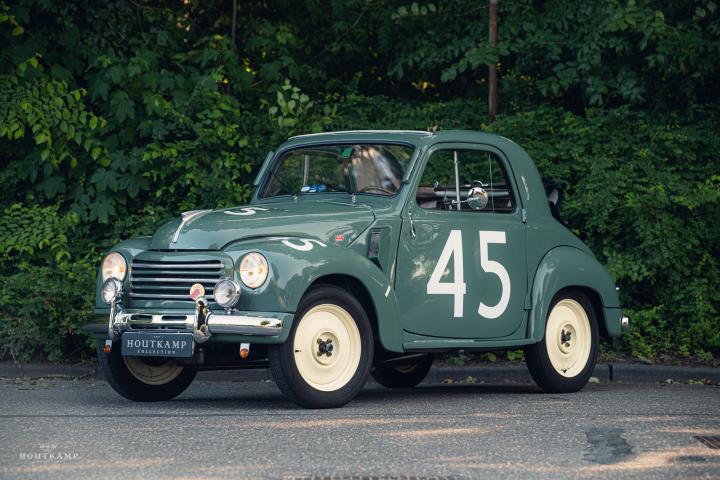This adorable Topolino comes with an extensive history file including period pictures and documentation from the Mille Miglia Museum Archive in Brescia
Reliable, restored example. A pleasure to drive on twisty roads, city streets, or in historic rallies like the Mille Miglia
An authentic piece of Italian motoring history, ready to be driven and enjoyed
Benefits from tasteful performance upgrades
Successfully competing in the 2018, 2019 and 2021 Mille Miglia
While behind the wheel of this tiny time machine, it’s easy to imagine cruising the Amalfi Coast with a charming companion or waiting nervously for the start of the 1953 Mille Miglia where this Fiat 500C participated in the enthusiastically crowded Turismo Nazionale 750 class.
The origins of the car are interesting, in 1930 Benito Mussolini spoke with Giovanni Agnelli about the imperative need to produce a low-cost car for the masses. It would be good “propaganda”, followed by Adolf Hitler’s Germany, where Ferdinand Porsche was called to put Volkswagen, “people’s car”, into production.
The car was to cost less than 5.000 Italian Lire: a difficult task.
The FIAT chief designer, Antonio Fessia, entrusted the task to a young Dante Giacosa, who took over the previous Balilla project by simplifying every detail: the body lines were inspired by the Fiat1500 with a tapered hood. Giacosa’s aeronautical experience inspired the lightened two-rail chassis, with the engine (569 cc, 4 cylinders, side valve) mounted cantilevered to improve space.
Everyone called the car “Topolino”, for its size and muzzle similar to a mouse, or more precisely to Walt Disney’s Mickey Mouse. In any case, the official name remained FIAT 500.
The final price of 8.900 Italian Lire was higher than the target and very high for an ordinary worker, but the car sold.
In 1938 the quarter elliptical rear leaf springs (the so-called “balestrino” or “balestra corta”) became normal semi-elliptical leaf springs to improve load capacity.
In 1948 the vehicle saw major changes with the “500 B” model, featuring overhead valves, improvements to the chassis and new heating.
A new version became available, the “Giardiniera Belvedere”, a small “woody” station wagon.
In 1949 there was the final change, with the “500 C” model.
The front part of the bodywork took on a more modern style, the engine received an aluminum cylinder head.
The small “Topolino” is one of the world’s best known cars. It was a car designed to be minimal and economical, but it seems that everyone wanted to use it to race.
The Topolino was often modified, little or radically, for races.
Production of the sedan lasted until 1954, replaced by the FIAT 600.
ABOUT THIS SPECIFIC EXAMPLE
It all began on 29th June 1952, when Mr. Giacomelli Arturo, a resident of Padova, purchased this Fiat Topolino.
The gentleman drove successfully in the 1953 Mille Miglia together to his codriver Mr. Gemo Antonio at an average speed of 85.68 km/h which was off-course amazing in 1953.
Shortly after the race, on 10th July 1953, the car changed hands but remained in Padova, owned by Mr. Modesto Lunardi.
Several years later, in 1961, the Topolino was purchased by another gentleman from Padova, Mr. Miro Barollo, who owned it until 31st August 1976, when, curiously, it returned to its former owner, Mr. Lunardi.
A further owner resident in Padova followed in 1990, Mr. Bruno Capovilla.
An ‘ACI Estratto Cronologico’ clarifies that the ‘Topolino’ passed through a modest chain of Italian owners.
In 1998, a new chapter opened as the car left Padova for Pisa, Tuscany, while still remaining true to its Italian roots.
In 2017, the Topolino was exported to the Netherlands, where it was welcomed with the same enthusiasm and care.
Under its Dutch ownership, the Topolino proudly returned to its roots, successfully competing in the 2018, 2019 and 2021 Mille Miglia.
Before and after each participation, the car has been meticulously maintained and given careful mechanical attention. Over € 16,000 has been invested in mechanical work alone.
The engine has been very nicely modified with special pistons, a special crankshaft and a special oil sump in aluminium to increase the power slightly to be even more fast in the current editions of the Mille Miglia.
The number 45 has a meaning as the car started as number 45 in the 1953 Mille Miglia. A detail which may never been taken off in our opinion.
CONDITION EXTERIOR
This charming Fiat Topolino presents beautifully. Finished in a timeless period-correct color with a lovingly maintained exterior that reflects both its heritage and careful restoration.
The paint is wonderful and the nice details of the original race number is off-course amazing.
The iconic Mille Miglia number “45” remains proudly displayed, a historic detail that connects this Topolino directly to its 1953 race participation.
Overall, the bodywork is solid, straight, and remarkably well cared for.
CONDITION INTERIOR
Stepping inside the Topolino feels like opening a time capsule from the early 1950s.
The cabin has been beautifully restored to maintain its original character, with period-correct upholstery that offer both comfort and nostalgia.
The dashboard, controls, and gauges are all functional and period-correct, offering a true vintage driving environment.
The cabin is clean, simple, elegant, and full of personality, the interior exudes warmth and historic charm, just as it would have on the start line of the 1953 Mille Miglia.
DRIVING EXPERIENCE
Getting behind the wheel of this 1951 Fiat Topolino is like stepping into a different era, one where the journey itself was the destination.
The car is driving fabulous and is running immediately and easy.
Its simplicity is part of its magic: everything you feel is mechanical, analog, and deeply connected to the road beneath you.
The carefully tuned engine provide just the right amount of extra energy for historic road events, without losing the essence of what makes the Topolino so beloved.
On an event like the Mille Miglia, this isn’t the car that flies past unnoticed, it’s the one that makes people cheer. Spectators recognize it, children wave at it, and fellow drivers nod with admiration.
Its original Mille Miglia race number “45” is more than a detail, it’s a badge of honor.




